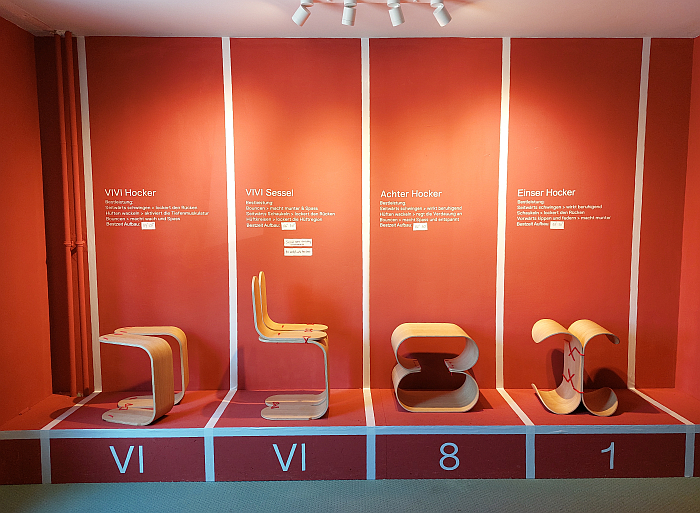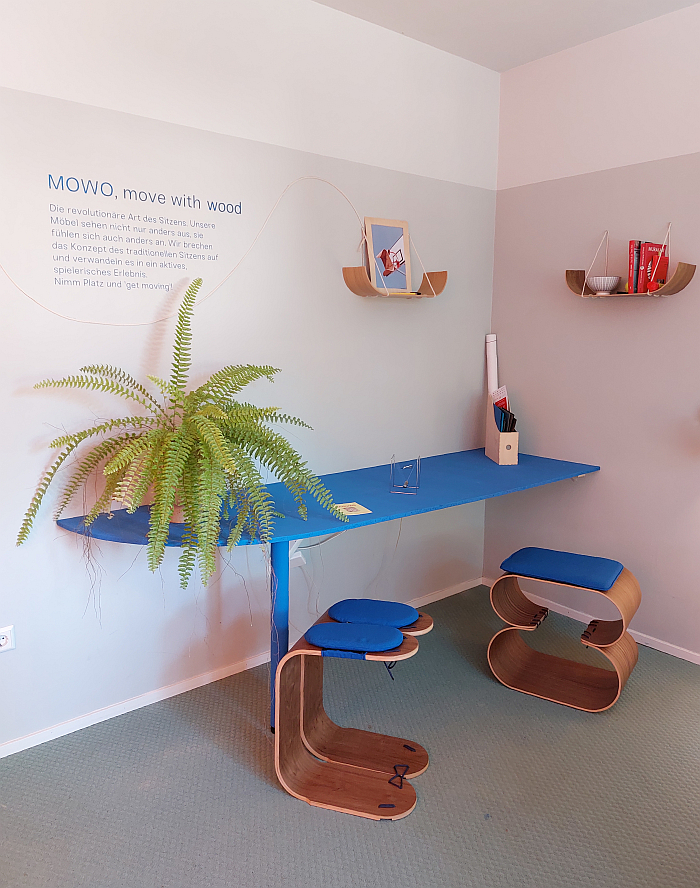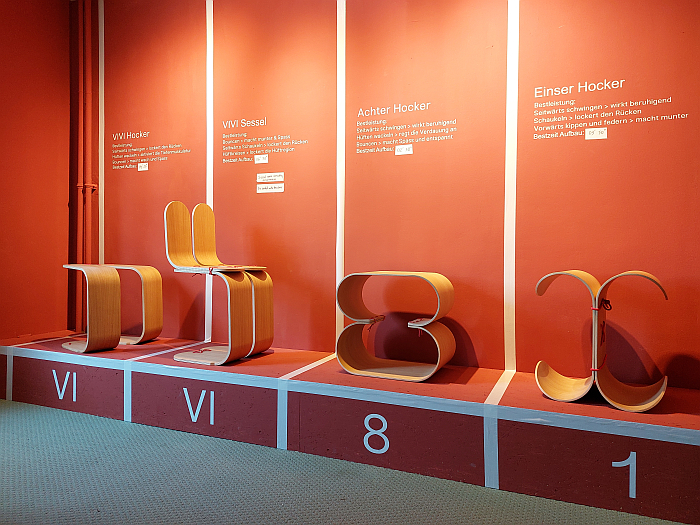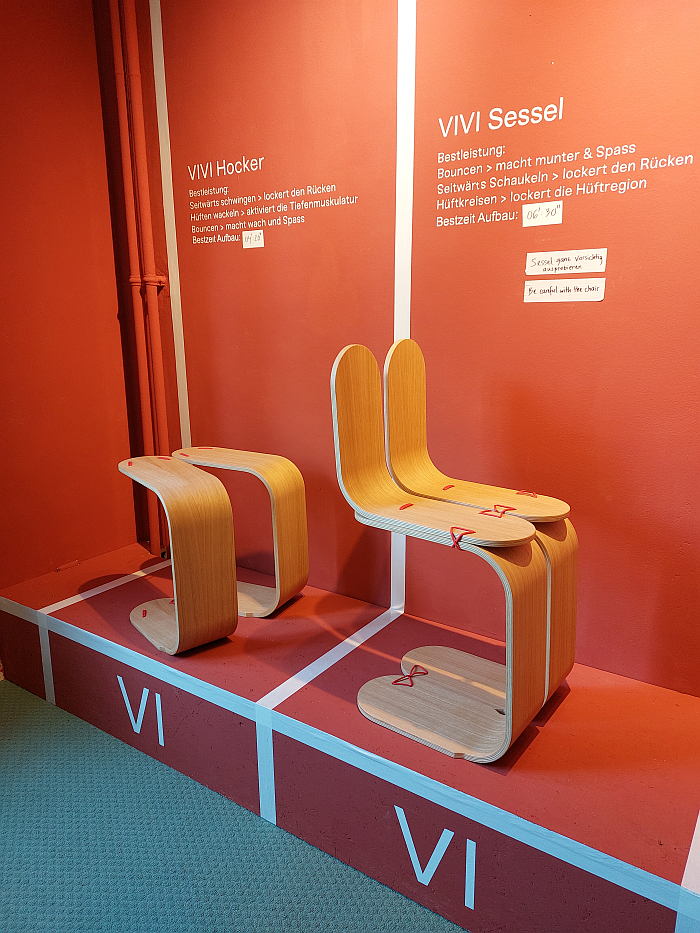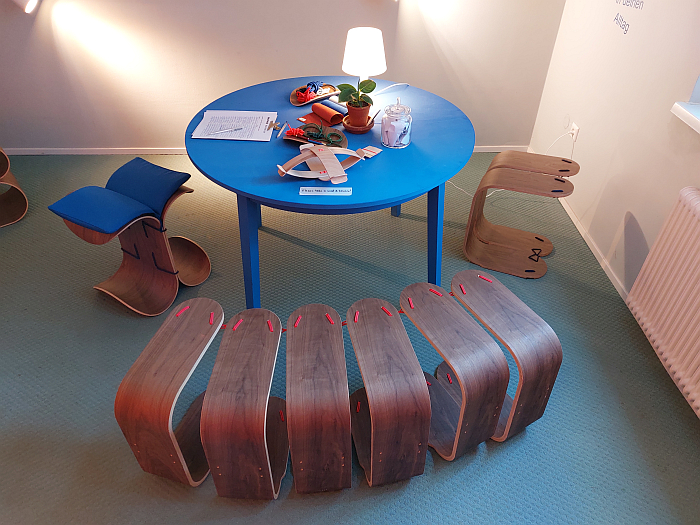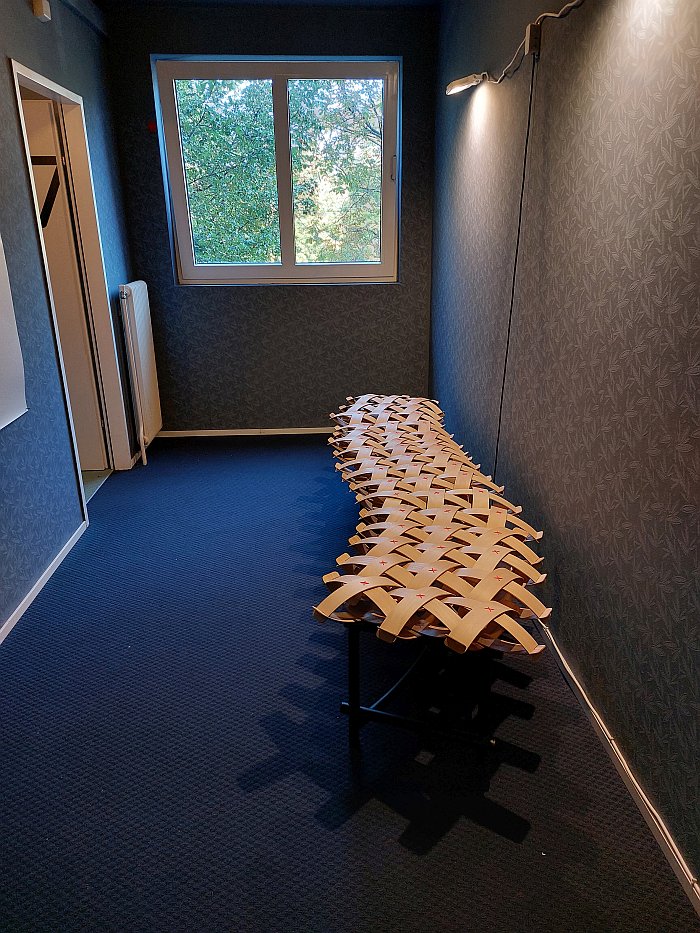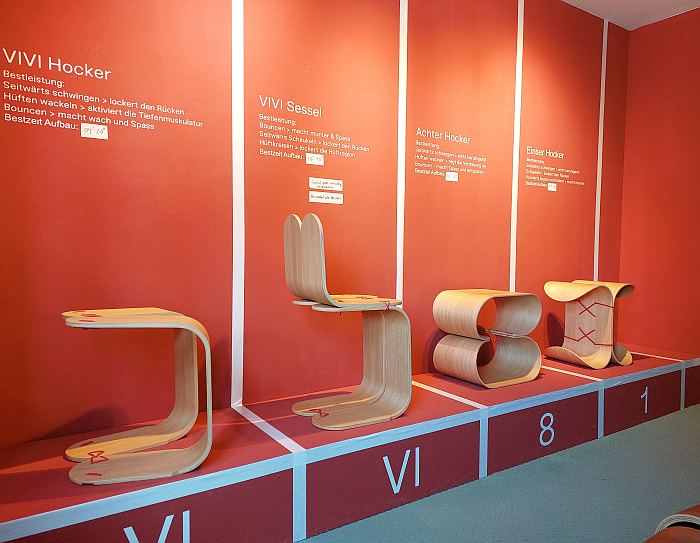
We first met MOWO, Move with Wood, and its designer Lisa Stolz, at the 2018 Central Saint Martins, London, Degree Show where it was very obviously our stand out project from that year's show, from that year's graduation projects at Central Saint Martins, being as it was the only project we discussed in any depth.
In 2021, in the midst of Corona, Lisa Stolz established, via a Kickstarter campaign, MOWO as company to produce the concept in both its variations on a theme, in both its understandings of wood as a material to move with.
One the one hand the Aera collection, a collection based around a weave of plywood springs, very resilient plywood springs which allow simultaneous movement in several directions, not quite the concentric springs of Thomas E. Warren's 19th century chair, but approaching that sort of freedom, without the harsh visual aesthetics one must add, no need to hide the springs behind an embroidered valance; plywood springs which on account of the manner in which they are inter-connected, inter-woven, can be employed as a number of genres, including, for example, a sofa, a bench or a floor/ground mat, and importantly can be freely, continually and instantly reformed and re-imagined depending on demand and requirements. And an Aera collection which, somewhat unforgivably, we skipped over in 2018, not through want of appreciation, but for want of space and time. An unavoidable reality.
Our focus in 2018 was very much what was, then, known as the C collection but is now the CC collection and the VIVI collection, two related collections based around a basic unit which we referred to in 2018 as giving "the impression of a badly damaged skateboard", a description we stand by, whereby Lisa has very clearly developed the objects since 2018. Or if one so will has re-damaged them. In a positive sense one understands.
The CC collection represented in 2023 by two objects familiar from 2018 which combine two damaged skateboards two moulded plywood Cs: the Achter - Figure of Eight - seeing one C placed upon an other to create... well, an 8 and the Einser - One - which places two Cs back to back to create a....yes, a one. Or an I. And both of which not only offer resilient seating, if in slightly different manners, but also allow for movement in other planes, allow on either to move while sitting or which move with you if your sitting is by necessity an active process.
The VIVI collection being, we're saying, we sadly didn't get to talk to Lisa, another unavoidable reality of any design week, but we're saying, a development of the single C stool presented in London, but now a lot more quadratic — if we cared about typography we could now quote an example of a shift from one typeface 'C' to another typeface 'C' to allow one to visualise the change from a rounded 'C' to a linear 'C', but we don't, so we can't — and with a slight modification to the base, we're, again, assuming we don't know, to enable the slightly more quadratic form to sit flat on the floor. And a VIVI collection presented in Vienna in three versions: the commercially available VIVI Stool and VIVI Bench which see, in the stool, two, and in the bench, multiple, single units joined together to form the respective stool/bench; and also presented in Vienna by a, as best we can ascertain, work in development, the VIVI Sessel which sees a VIVI Stool extended by two new shapes, we're saying L's, to create a backrest.
And a VIVI Sessel that, for us, still needs a little work, technically and conceptually. For while the VIVI Stool and VIVI Bench, and indeed the Achter and Einser offer not only a very satisfying resilience and free movement in a number of directions they also offer and supply a very high degree of seating security, you feel supremely safe on them, know that you're supported, forget they are there; in contrast on the VIVI Sessel we were very aware of it, and were not at all convinced it was enjoying the experience and responsibility of taking our weight.
Which confused us, greatly, until, and at the very real risk of making a suggestion to someone more qualified to assess and analysis these things than us, it occurred to us that the base is the wrong way round.
And we know why its the wrong way round: cantilever. We fully appreciate the desire to create a cantilever, and also the why of that desire, the cantilever is always a joy, and we would indeed argue that the very nature of MOWO is crying out for a cantilever; but, the VIVI Stool allows for a much more secure seating solution, a much more positive experience, with the open section at the front, the other way round is a much less relaxing experience, on sits nervously, almost apologetically, certainly self-consciously on the front edge. And while it may be possible, as, for example the brothers Bodo und Heinz Rasch or a Jean Prouvé did with their early steel tube cantilevers, to find some way to reinforce the material to allow for a stabler cantilever, a more confident sitting experience, one could always embrace the opening at the front.
No, the figure thus cut isn't as pleasing as the cantilever always is, but would place it very much in the tradition of school chairs designed to be hung on desks to aid cleaning, a form of chair not without its advantages and charms in, for example, canteens, cafes, libraries, lobbies, call centres, co-working spaces or contemporary offices with their mix of zones and need for representative furniture. Where representative is very much to be understood in its contemporary understanding and not its 18th century understanding.
Or ignore the backrest. Does MOWO actually need a backrest? Is a backrest not, as a Willy Guhl or a Marcel Breuer teach us, something that limits movement, is a free spine not a pre-requisite for free movement? We see the thinking behind the development of a backed-chair, we can follow the path that leads from stool to back-stool, but is that reason, is that journey, in the interests of MOWO? We're not convinced it is. Or, alternatively, is it not a task for Aera rather than VIVI? Visually we very much enjoyed the VIVI Sessel, but must it be as it currently is?
And while we're making unqualified and unsolicited suggestions, for all that we appreciate the reasons for the string connectors, we'd still favour, as noted in 2018, a more responsive connection system that allowed for a quicker, less involved connection, disconnection, reconnection, re-disconnection, etc
Not that such distracts from the joy of MOWO.
How could it?
Certainly not when one considers the new cushions that Lisa has designed for the various models, cushions that for all one could argue are superfluous, we've never queried the sitting comfort, that's was always a given, not only make the objects slightly more approachable, less daunting, but also allow for an easier integration into spaces where upholstery is expected; cushions which effortlessly expand the objects without altering their character.
But for all cannot distract nor detract from the very pleasing and most satisfying movement allowed and supported by the MOWO collection, that ability to move with wood Lisa Stolz has so satisfyingly enabled; movement which one controls with nothing more the the thighs and hips, which is obviously as beneficial as it is practical. And movement facilitated by a delightful, joyous, stupidly simple, utilisation of the inherent resistance of plywood; that resistance once employed by the likes of the Aaltos, or Breuer or the Eames but, in contrast to the Aaltos, Breuer or Eames, without going to the length of designing actual pieces of sitting furniture.
A self-evident lack of furnitureness that not only only stands indicative of how relationships with and understandings of furniture have evolved over the decades, or perhaps more accurately have returned to more archaic, primitive, relationships and understandings of a seat as something you sit on that were popular before designers complicated everything, but also means the MOWO collections are, or can be, at home anywhere: they are a proposition not an object, an offer not an answer, and thus can engage with all freely, openly and honestly.
For all in or near Vienna MOWO - Move with Wood can be viewed, and tested, and discussed with Lisa Stolz, in the Vienna Design Week Festivalzentrale in Prater, 2., Laufbergergasse 12 until Sunday October 1st. Details of opening times and the accompanying programme can be found at www.viennadesignweek.at
And for everyone else more information, and an online shop, can be found at https://mowo.studio
